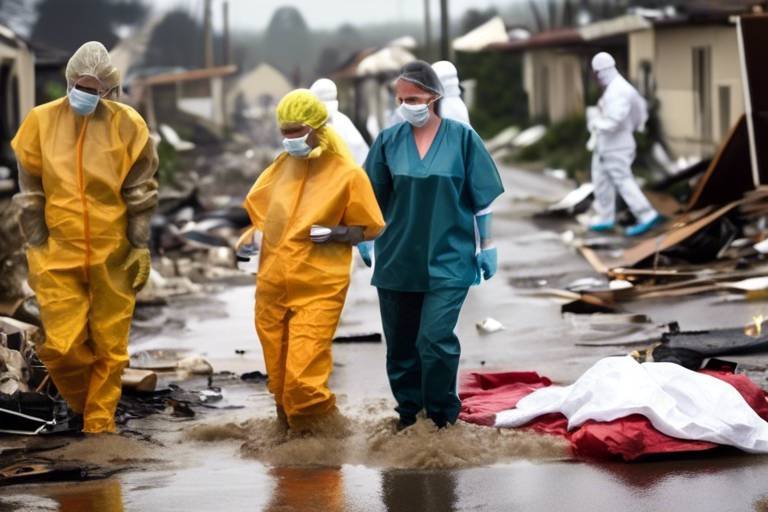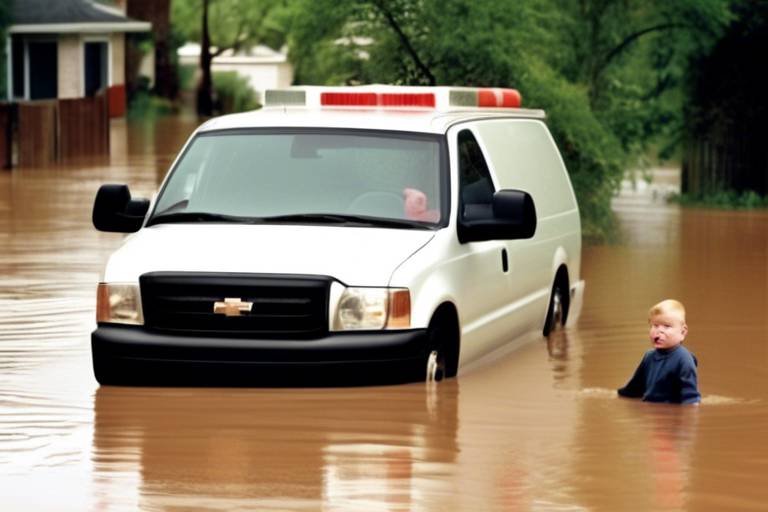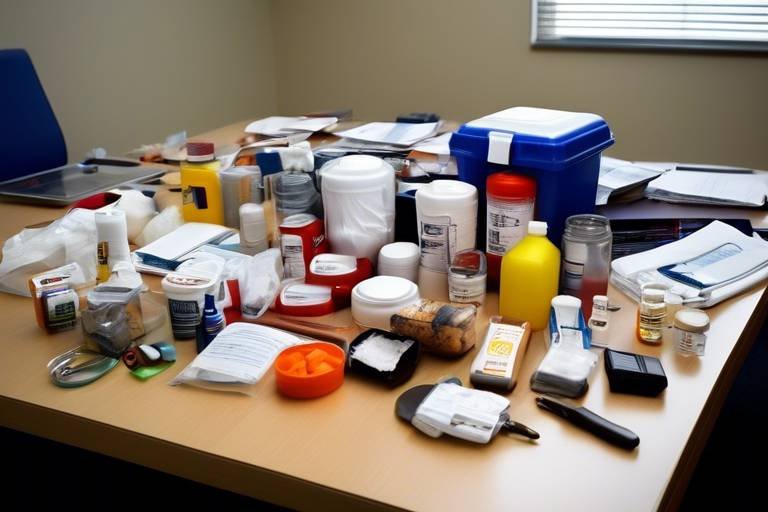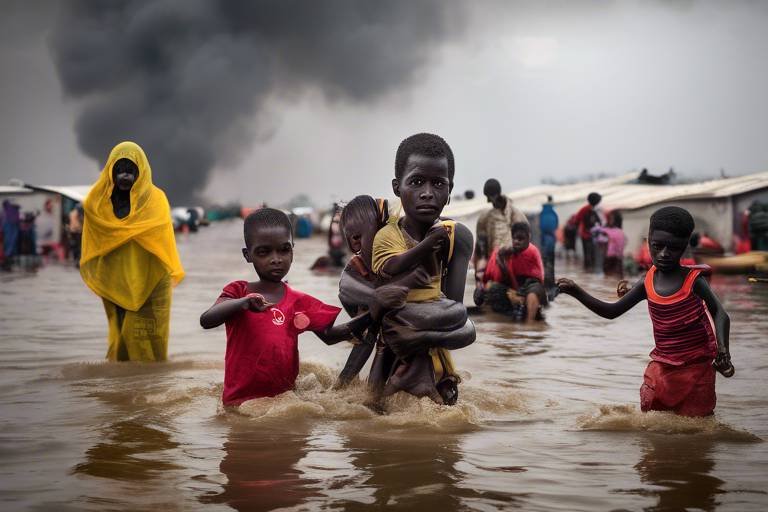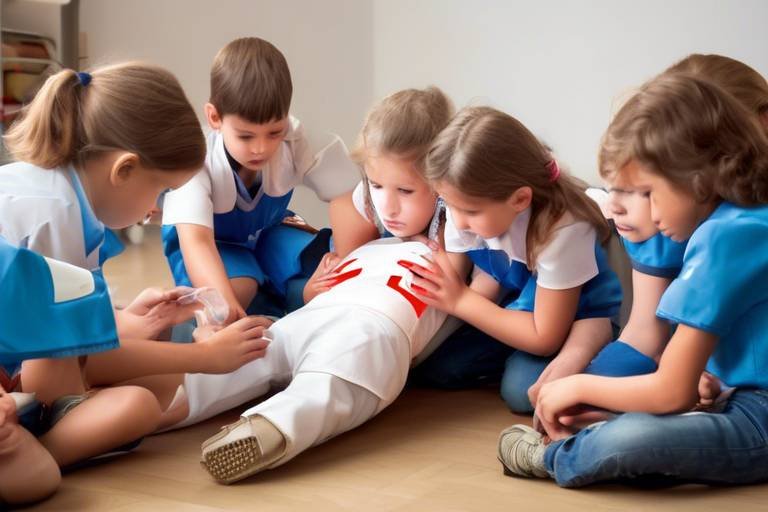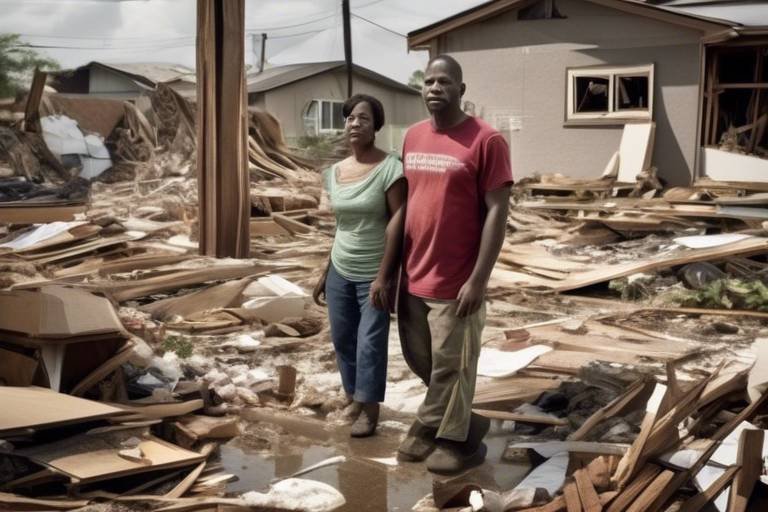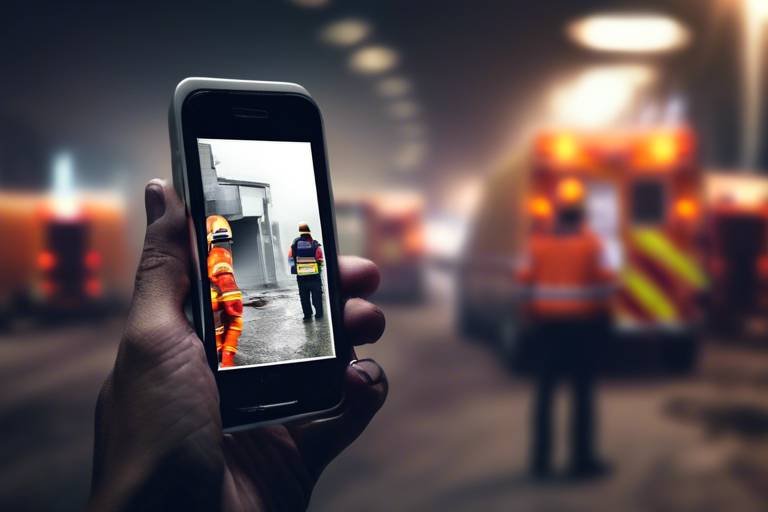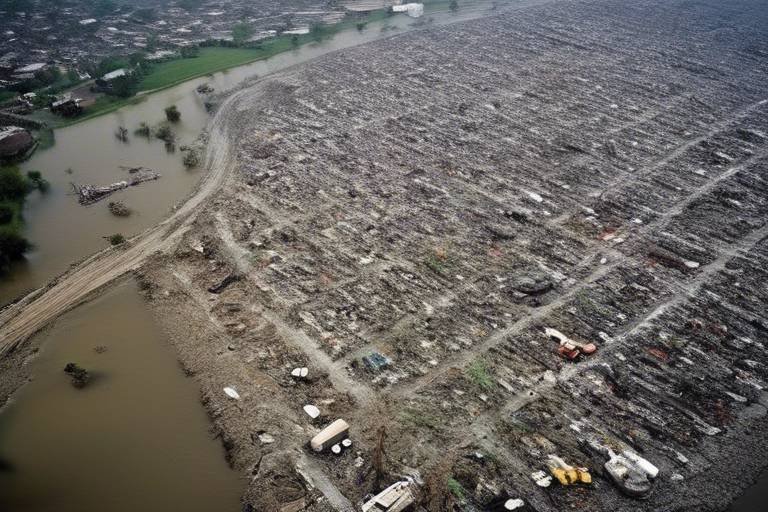The Role of Health Professionals During a Disaster
Disasters can strike without warning, turning lives upside down in mere moments. In these chaotic times, health professionals emerge as the backbone of emergency response, providing essential services that save lives and restore hope. Their roles are not just limited to treating injuries; they encompass a wide range of critical functions that ensure the health and safety of affected populations. From coordinating emergency responses to offering psychosocial support, these dedicated individuals are at the forefront of disaster management, navigating the complexities of healthcare delivery in high-pressure environments.
Imagine a scenario where a community is suddenly faced with a natural disaster, such as a hurricane or earthquake. In the aftermath, health professionals step in like the calm in the storm, orchestrating a symphony of care amidst the chaos. They are the ones who assess the situation, determine the most pressing health needs, and mobilize resources to meet those needs effectively. Their ability to think on their feet and adapt to rapidly changing circumstances is nothing short of remarkable.
Moreover, health professionals play a crucial role in public health surveillance during disasters. They monitor the health status of populations, identifying emerging threats such as disease outbreaks or mental health crises. This proactive approach allows for timely interventions that can prevent further harm. In this way, health professionals not only respond to immediate medical needs but also work to safeguard the long-term health of communities.
In essence, the role of health professionals during a disaster is multifaceted and vital. Their expertise, compassion, and dedication ensure that even in the darkest times, there is a glimmer of hope. As we delve deeper into the various functions they perform, we’ll uncover the intricacies of their responsibilities, the challenges they face, and the profound impact they have on the lives of those they serve.
Health professionals play a vital role in coordinating emergency responses, ensuring that medical resources are allocated effectively and that communication channels remain open among various agencies during a disaster. They act as liaisons between hospitals, government agencies, and community organizations, facilitating a smooth flow of information and resources. Without their leadership and coordination, the response to a disaster could quickly become disorganized and ineffective.
Monitoring and assessing the health status of populations during disasters is crucial. Health professionals are responsible for public health surveillance to identify emerging health threats and implement timely interventions. They collect data on injuries, illnesses, and behavioral health issues, which helps to inform public health decisions. The importance of this role cannot be overstated; it is the foundation upon which effective disaster response is built.
Collecting and analyzing health data during disasters helps to inform response strategies. Health professionals utilize this information to track disease outbreaks and resource needs in affected communities. For example, they might identify a spike in respiratory issues following a natural disaster and implement measures to address air quality. This data-driven approach ensures that interventions are targeted and effective.
Advanced technologies, such as mobile health applications, enhance data collection efficiency. Health professionals leverage these tools to ensure real-time access to critical health information during emergencies. This technological integration allows for rapid response and better resource management, ultimately leading to improved outcomes for affected populations.
Effective data management often requires collaboration with local health agencies. Health professionals work together to share insights and improve the overall response to health crises. This teamwork fosters a sense of community and ensures that all voices are heard in the decision-making process.
Educating communities about health risks and available resources is essential during disasters. Health professionals lead outreach efforts to empower individuals with knowledge and skills to protect their health. By providing information on hygiene practices, mental health resources, and how to access medical care, they help communities become more resilient in the face of adversity.
Efficient management of medical resources is crucial in disaster situations. Health professionals are tasked with prioritizing and distributing supplies to ensure that those in need receive timely care. This often involves making tough decisions about where to allocate limited resources, ensuring that the most vulnerable populations are prioritized.
Assessing the most urgent health needs during a disaster allows health professionals to allocate resources effectively. This prioritization is key to maximizing the impact of available medical supplies. By focusing on the areas of greatest need, they can make a significant difference in the overall health outcomes of affected individuals.
Health professionals often train and mobilize volunteers to assist in disaster response efforts. This collaboration enhances the capacity to provide care and support to affected populations. Volunteers, guided by trained health professionals, can help distribute supplies, provide basic medical care, and support mental health initiatives, creating a stronger community response.
Addressing the mental health needs of disaster survivors is vital. Health professionals provide psychosocial support services to help individuals cope with trauma and stress resulting from the disaster. This support can take many forms, from counseling to community support groups, and is essential for fostering resilience in the aftermath of a crisis.
Counseling programs are essential for promoting mental well-being. Health professionals develop and implement these programs to assist individuals in managing their emotional responses to disasters. By offering a safe space for individuals to express their feelings, they help pave the way for healing and recovery.
Health professionals contribute to building community resilience by fostering social support networks. These networks are crucial for recovery and long-term mental health following a disaster. By encouraging connections among community members, health professionals help create a support system that can withstand future challenges.
Q: What is the primary role of health professionals during a disaster?
A: Health professionals coordinate emergency responses, monitor public health, allocate resources, and provide psychosocial support to affected populations.
Q: How do health professionals ensure effective communication during a disaster?
A: They act as liaisons between various agencies, ensuring that information flows smoothly and resources are allocated where they are needed most.
Q: Why is public health surveillance important during disasters?
A: It helps identify emerging health threats and allows for timely interventions to protect the health of affected populations.
Q: How do health professionals support mental health during disasters?
A: They provide counseling services and create community support networks to help individuals cope with trauma and stress.
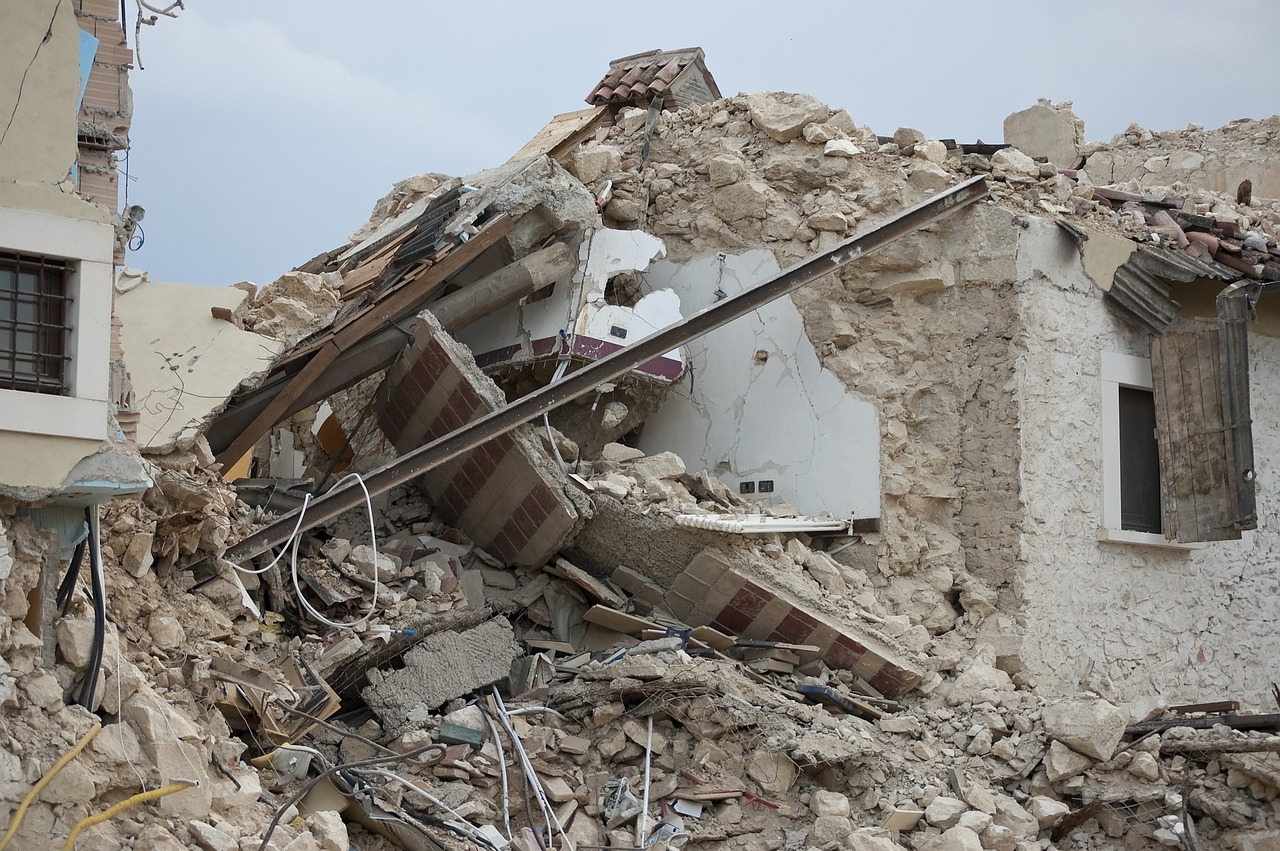
Emergency Response Coordination
In the chaotic aftermath of a disaster, health professionals emerge as the backbone of emergency response coordination. Their role is not just about providing immediate medical care; it encompasses a vast array of responsibilities that are crucial for effective disaster management. Imagine a ship navigating through a storm—health professionals are the skilled crew members who ensure that the vessel remains steady and on course amidst the turbulent waters of crisis. They coordinate with various agencies, including government bodies, NGOs, and local health departments, to ensure that medical resources are allocated effectively and efficiently.
One of the primary responsibilities of health professionals during a disaster is to establish and maintain open communication channels among all parties involved. This involves not only sharing vital information but also ensuring that everyone is on the same page regarding the needs of the affected population. For instance, during a natural disaster like a hurricane, health professionals might work alongside emergency services to assess the situation and prioritize areas that require immediate medical attention. This coordination is essential for preventing chaos and ensuring that help reaches those who need it the most.
Furthermore, health professionals engage in logistical planning to manage the flow of resources. This can include everything from medical supplies to personnel. They often utilize advanced technologies, such as geographic information systems (GIS), to map out affected areas and identify where resources are most needed. By visualizing the data, they can make informed decisions that maximize the impact of their efforts. For example, if a particular district is hit harder than others, health professionals can quickly redirect supplies and personnel to that area, ensuring timely care for the victims.
In addition to logistical planning, health professionals are also tasked with training and mobilizing volunteers. This is where community engagement becomes vital. By training local volunteers, health professionals create a network of support that can extend the reach of medical care. Volunteers can assist with various tasks, from distributing supplies to providing basic first aid, thereby alleviating some of the burdens on healthcare facilities that may be overwhelmed during a disaster. It's a classic example of community resilience—when individuals come together to support one another, the entire community becomes stronger.
In summary, the role of health professionals in emergency response coordination is multifaceted and crucial for the overall success of disaster management efforts. Their ability to communicate effectively, plan logistically, and engage the community not only ensures that resources are utilized efficiently but also enhances the resilience of the affected population. As we delve deeper into the various aspects of health professionals' roles during disasters, it becomes evident that their contributions are indispensable in safeguarding public health and ensuring the well-being of communities in crisis.

Public Health Surveillance
In the chaotic aftermath of a disaster, the role of health professionals in becomes paramount. Imagine a ship lost at sea, desperately needing a lighthouse to guide it home; that’s how crucial health monitoring is during such turbulent times. Health professionals are on the front lines, tirelessly working to assess and monitor the health status of affected populations. Their responsibilities extend beyond merely treating injuries; they must also identify emerging health threats that could escalate into larger crises if left unchecked.
One of the primary functions of public health surveillance during disasters is to gather real-time data regarding the health of the community. This data collection is not just a matter of counting the number of injuries or illnesses; it involves a comprehensive look at the overall health landscape. Health professionals utilize various methods to collect this vital information, including:
- Surveys and questionnaires distributed among affected populations.
- Collaboration with local agencies to share insights and data.
- Utilizing mobile health applications to gather real-time data.
These efforts culminate in a clearer picture of the health challenges faced by the community. For instance, if a disaster leads to contaminated water supplies, health professionals can quickly identify an increase in gastrointestinal illnesses through surveillance data. This information allows them to implement timely interventions, such as distributing clean water and providing education on safe hygiene practices. Without effective public health surveillance, these emerging threats could spiral out of control, leading to preventable illnesses and fatalities.
Collecting and analyzing health data during disasters is akin to piecing together a jigsaw puzzle where each piece represents a different aspect of community health. Health professionals meticulously analyze this data to track disease outbreaks and assess resource needs. By understanding the health trends within the affected population, they can make informed decisions that guide the allocation of medical resources. For example, if the data indicates a spike in respiratory issues due to dust and debris, health professionals can prioritize the distribution of inhalers and respiratory support.
In today’s digital age, advanced technologies have revolutionized the way health professionals manage data during emergencies. Mobile health applications and online platforms enable swift data collection and dissemination, ensuring that critical health information is accessible in real-time. Imagine having a command center where data flows seamlessly, allowing health professionals to react promptly to emerging health threats. These technologies not only enhance efficiency but also improve the accuracy of the information being collected.
Effective public health surveillance often hinges on collaboration with local health agencies. In a disaster scenario, no one can afford to work in isolation. Health professionals join forces with local agencies to share insights, pool resources, and improve the overall response to health crises. This teamwork is essential, as it allows for a more comprehensive understanding of the health challenges at hand. By pooling their knowledge and resources, health professionals can ensure a coordinated response that addresses the immediate needs of the community while also planning for long-term recovery.
In conclusion, public health surveillance is a critical function that health professionals perform during disasters. It not only helps in identifying emerging health threats but also informs the strategies needed to address these challenges effectively. As we navigate the complexities of disaster response, it’s clear that a robust public health surveillance system is vital for safeguarding the health and well-being of affected populations.
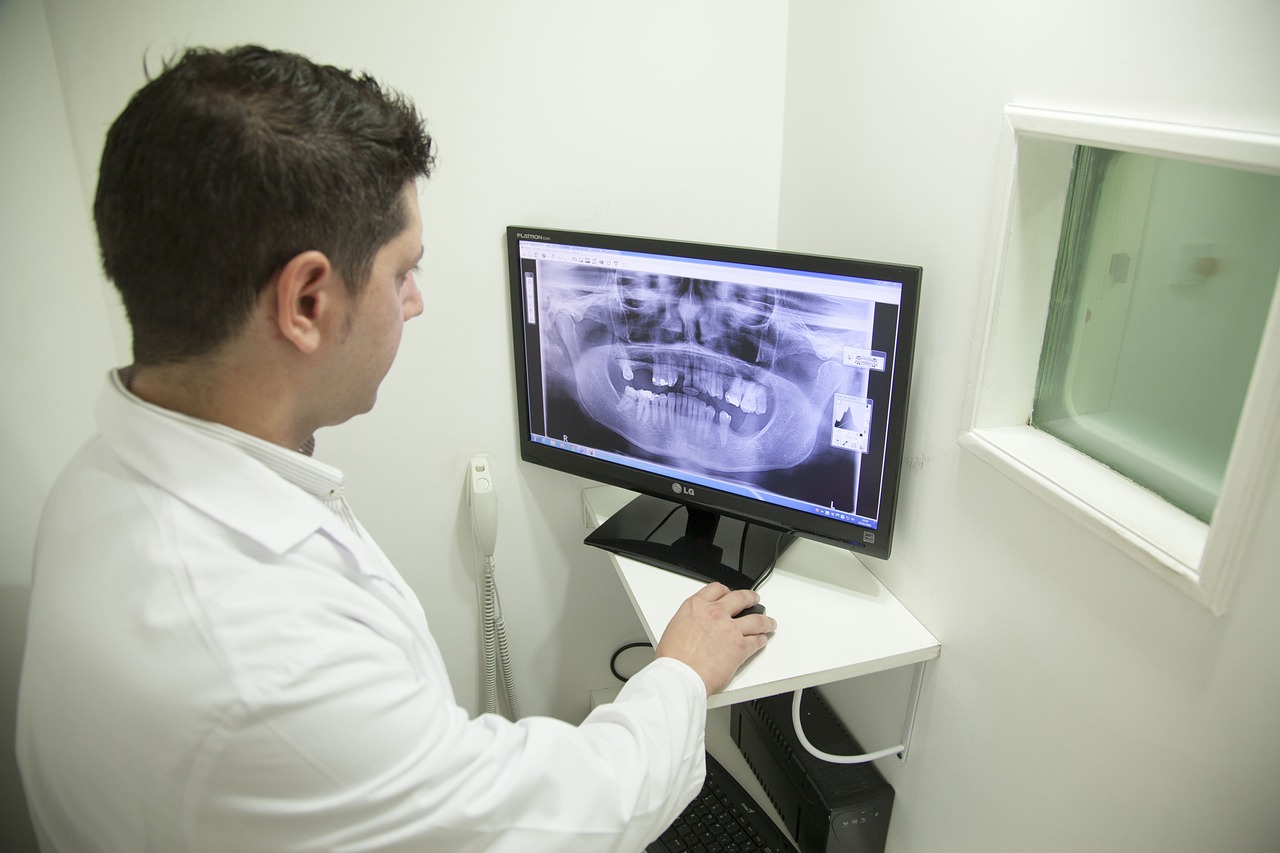
Data Collection and Analysis
When disaster strikes, the clock starts ticking, and every second counts. This is where the role of health professionals in becomes paramount. They are the detectives of the health world, gathering clues that can lead to effective responses to emerging health threats. Imagine a chaotic scene where every piece of information is like a puzzle piece; health professionals work tirelessly to fit these pieces together to create a complete picture of the situation.
During a disaster, health professionals engage in systematic data collection, which involves gathering information on various health indicators such as disease prevalence, injury rates, and mental health issues. This data is not just numbers on a sheet; it tells a story about the health status of the affected population. For example, if a sudden outbreak of a contagious disease is detected, it can trigger an immediate response to contain it. The importance of this data cannot be overstated; it is the lifeblood of informed decision-making.
Furthermore, the analysis of this data helps in identifying trends and patterns that can signify larger health issues. Health professionals utilize various statistical tools and methodologies to analyze the data collected. This analysis can reveal critical information, such as:
- Which areas are most affected by specific health threats?
- What resources are needed to address these threats?
- How effective are the current interventions in place?
To illustrate the impact of data analysis, consider a recent disaster scenario where health professionals used data to track the spread of a waterborne disease after a flood. By analyzing health records and conducting surveys, they were able to pinpoint the most affected neighborhoods, allowing for targeted interventions such as clean water distribution and health education campaigns. Without such data-driven strategies, resources might have been wasted on less affected areas, ultimately prolonging the suffering of those in dire need.
Moreover, the integration of technology in data collection has revolutionized how health professionals operate during disasters. Mobile health applications and online databases allow for real-time data entry and analysis. This means that as soon as health professionals gather information, they can analyze it on the spot, leading to quicker responses. For instance, a team using a mobile app to report cases of illness can instantly share this information with local health authorities, who can then mobilize resources to address the outbreak.
Collaboration is another critical aspect of effective data collection and analysis. Health professionals often work alongside local agencies and organizations to enhance data accuracy and comprehensiveness. By pooling resources and knowledge, they can ensure that the data collected reflects the true health status of the community. This collaborative approach not only strengthens the response but also fosters trust within the community, as people see their health professionals actively engaged in addressing their needs.
In summary, the role of health professionals in data collection and analysis during disasters is not just about numbers; it’s about understanding the narrative behind those numbers. By using innovative technologies, collaborating with local agencies, and analyzing data effectively, health professionals can make informed decisions that save lives and promote recovery in the wake of disasters.
- Why is data collection important during a disaster?
Data collection is crucial as it helps health professionals understand the health status of affected populations and informs timely interventions. - How do health professionals analyze data during disasters?
They use statistical tools and methodologies to identify trends, patterns, and urgent health needs based on the collected data. - What role does technology play in data collection?
Technology enhances the efficiency of data collection and analysis, allowing for real-time updates and quicker responses to health threats. - Why is collaboration important in data collection?
Collaboration with local agencies ensures comprehensive data collection, enhancing the accuracy and effectiveness of health interventions.

Utilizing Technology for Data Management
In today's fast-paced world, the integration of technology into data management has revolutionized how health professionals respond during disasters. Imagine being able to gather and analyze crucial health data in real-time, enabling swift decision-making when every second counts. This is where technology steps in, transforming the landscape of emergency response. Advanced tools, such as mobile health applications and cloud-based data systems, empower health professionals to collect, store, and disseminate information efficiently.
One significant advantage of utilizing technology is the ability to maintain real-time communication among various stakeholders. For example, health professionals can use mobile platforms to report disease outbreaks or resource shortages instantly. This immediate feedback loop ensures that everyone involved, from local agencies to international organizations, is on the same page. Additionally, these technologies facilitate the sharing of best practices and lessons learned from previous disasters, which can be invaluable in improving future responses.
Moreover, the use of data visualization tools allows health professionals to interpret complex datasets quickly. By transforming raw data into visual formats like graphs and charts, they can identify trends and patterns that may indicate emerging health threats. For instance, if a specific area shows a spike in respiratory illnesses following a natural disaster, this information can trigger targeted interventions, such as deploying medical teams or distributing resources.
However, the effectiveness of technology in data management is not solely dependent on the tools themselves; it also hinges on the collaboration between health professionals and local agencies. By working together and sharing insights, they can enhance the overall response to health crises. This collaboration often involves training local staff to use technology effectively, ensuring that everyone is equipped to handle the demands of a disaster situation.
In summary, the utilization of technology for data management during disasters is a game-changer. It streamlines communication, enhances data analysis, and fosters collaboration among health professionals and local agencies. As we continue to face natural calamities and health emergencies, embracing these technological advancements will be crucial in safeguarding the health and well-being of affected populations.
- What types of technology are commonly used in disaster response?
Mobile health applications, cloud-based data systems, and data visualization tools are commonly utilized to manage health data during disasters. - How does technology improve communication during disasters?
Technology enables real-time reporting and sharing of information among health professionals and agencies, ensuring coordinated responses. - Why is collaboration important in utilizing technology for data management?
Collaboration enhances the effectiveness of data management efforts, as it allows for the sharing of insights and best practices among local agencies and health professionals.

Collaboration with Local Agencies
During a disaster, the importance of cannot be overstated. Health professionals are often at the forefront of coordinating efforts with various organizations, including governmental bodies, non-profits, and community groups. This teamwork is essential for creating a seamless response to the urgent health needs that arise in the aftermath of a disaster. By working hand-in-hand with local agencies, health professionals can ensure that resources are not duplicated and that every effort is directed towards the most pressing challenges faced by the affected population.
One of the primary benefits of this collaboration is the ability to share critical information. Local agencies often have intimate knowledge of the community they serve, including the demographics, existing health issues, and available resources. Health professionals can tap into this wealth of knowledge to better understand the specific needs of the population, allowing for a more tailored and effective response. Furthermore, by establishing clear communication channels, health professionals can relay real-time updates on the health status of the community, which is vital for effective decision-making.
Moreover, collaboration fosters a sense of community ownership in disaster response efforts. When local agencies are involved, community members are more likely to participate in health initiatives and follow public health guidelines. This collaboration can also enhance the credibility of health messages, as local agencies often have established trust within the community. For instance, a local non-profit organization that has worked with residents for years can help disseminate health information more effectively than outside agencies that may not have the same level of rapport.
In addition to improving communication and trust, collaboration also allows for better resource allocation. During a disaster, resources can be scarce, and health professionals must prioritize their distribution. By working with local agencies, they can gain insights into which areas need the most help and adjust their strategies accordingly. This coordinated approach can significantly improve the efficiency of the response, ensuring that those who are most vulnerable receive the care they need in a timely manner.
To illustrate the impact of collaboration, consider the following table that outlines how health professionals and local agencies can work together in various aspects of disaster response:
| Aspect of Collaboration | Health Professionals' Role | Local Agencies' Role |
|---|---|---|
| Information Sharing | Provide health data and updates | Share community insights and resources |
| Resource Allocation | Assess health needs and prioritize | Identify areas of high demand |
| Community Engagement | Educate the public on health risks | Mobilize community support and volunteers |
| Long-term Recovery | Implement health programs | Support community rebuilding efforts |
In conclusion, the collaboration between health professionals and local agencies is a crucial component of effective disaster response. By leveraging each other's strengths, they can create a comprehensive approach that not only addresses immediate health needs but also lays the groundwork for long-term recovery and resilience in the community.
- Why is collaboration important during a disaster? Collaboration ensures that resources are used efficiently and that health responses are tailored to the specific needs of the community.
- How can local agencies assist health professionals? Local agencies can provide valuable insights about the community and help disseminate information effectively.
- What role do volunteers play in disaster response? Volunteers help extend the reach of health professionals by providing additional support and resources during emergencies.
- How can communities prepare for potential disasters? Communities can prepare by establishing local response plans, training volunteers, and fostering partnerships with health professionals.

Community Education and Outreach
During a disaster, the role of health professionals extends far beyond immediate medical care; they become the lifeline of information and education for affected communities. The importance of cannot be overstated, as it empowers individuals to make informed decisions that can significantly impact their health and safety. Imagine being in a chaotic situation where every second counts—having the right information can be the difference between life and death. Health professionals step in to provide crucial knowledge about health risks, available resources, and preventive measures, ensuring that individuals are not left in the dark.
One of the key aspects of community education is the dissemination of information regarding health risks that may arise during a disaster. For instance, after a flood, there may be a surge in waterborne diseases. Health professionals educate the community about the symptoms of these diseases and preventive measures they can take, such as boiling water or using purification tablets. This proactive approach not only helps in preventing outbreaks but also builds a sense of community resilience.
Additionally, health professionals often conduct workshops and informational sessions to engage the community. These sessions may cover a range of topics, including:
- First aid techniques
- Emergency preparedness plans
- Mental health coping strategies
- Available health services and resources
Through these interactive sessions, community members not only receive valuable information but also have the opportunity to ask questions and express their concerns. This dialogue fosters trust and encourages individuals to seek help when needed. Moreover, health professionals often collaborate with local organizations and agencies to amplify their outreach efforts. By joining forces, they can tap into existing networks and reach a broader audience, ensuring that no one is left behind during a crisis.
In the digital age, technology plays a pivotal role in enhancing community education. Health professionals utilize social media platforms, mobile applications, and community websites to share real-time updates and educational content. For example, during a viral outbreak, timely updates about symptoms, prevention methods, and treatment options can be shared instantly, allowing the community to stay informed and vigilant. This use of technology not only facilitates rapid communication but also engages younger generations who are more likely to access information online.
Ultimately, effective community education and outreach are about creating a culture of preparedness and resilience. By equipping individuals with knowledge and skills, health professionals empower them to take charge of their health and well-being. In the aftermath of a disaster, this empowerment can lead to a quicker recovery and a stronger, more connected community. It's not just about surviving the disaster; it's about thriving in its wake.
Q: Why is community education important during a disaster?
A: Community education helps individuals understand health risks, available resources, and preventive measures, enabling them to make informed decisions that can save lives.
Q: How do health professionals engage with communities?
A: Health professionals conduct workshops, informational sessions, and utilize digital platforms to share critical information and foster dialogue within the community.
Q: What role does technology play in community outreach?
A: Technology enhances communication and information dissemination, allowing health professionals to provide real-time updates and engage a wider audience.

Resource Allocation and Management
In the chaotic aftermath of a disaster, the efficient management of medical resources can be the difference between life and death. Health professionals find themselves at the forefront of this crucial task, where every decision can have significant implications. They must assess the situation swiftly, determining what resources are available and how to allocate them most effectively to meet the urgent needs of those affected. This is not just about distributing supplies; it’s about making strategic decisions that can save lives.
One of the primary responsibilities of health professionals during a disaster is to identify the most pressing health needs of the community. This involves conducting rapid assessments to gauge the extent of injuries, illnesses, and other health-related issues. For instance, they might ask questions such as: What are the most common injuries? Are there outbreaks of infectious diseases? Is there a need for mental health support? By answering these questions, health professionals can prioritize their actions and allocate resources where they are needed most.
Resource allocation isn't a one-size-fits-all approach. Different disasters require different responses. In a hurricane, for example, there may be a need for immediate shelter and trauma care, while a pandemic might necessitate widespread testing and vaccination efforts. Health professionals must adapt their strategies based on the unique challenges presented by each disaster scenario. This dynamic nature of resource management requires not only expertise but also a robust communication network among various agencies and organizations.
To illustrate the complexity of resource allocation, consider the following table that outlines the types of resources typically needed during various disasters:
| Type of Disaster | Primary Resources Needed | Key Considerations |
|---|---|---|
| Earthquake | Trauma supplies, shelter materials | Rapid assessment of injuries and structural safety |
| Flood | Water purification, food supplies | Risk of waterborne diseases and displacement |
| Pandemic | Vaccines, PPE, testing kits | Community education and prevention strategies |
Another crucial aspect of resource management is the training and mobilization of volunteers. Health professionals often find themselves in a position where they need to enlist the help of community members and volunteers. This not only increases the capacity to deliver care but also fosters a sense of community involvement and resilience. Training volunteers to assist in various capacities—whether it be in triage, logistics, or emotional support—can significantly enhance the overall response to a disaster.
Moreover, health professionals must continuously monitor and reassess resource allocation as the situation evolves. What may have been a priority in the first few hours of a disaster can change dramatically as new information becomes available. This adaptability is crucial in ensuring that resources are not wasted and that they are utilized to their fullest potential.
In conclusion, the role of health professionals in resource allocation and management during disasters is multifaceted and critical. Their ability to quickly assess needs, prioritize actions, and mobilize resources can significantly impact the health outcomes of affected populations. As disasters become more frequent and complex, the importance of preparedness and effective resource management cannot be overstated.
- What are the primary responsibilities of health professionals during a disaster? Health professionals are responsible for assessing health needs, coordinating resources, providing care, and offering psychosocial support.
- How do health professionals prioritize resource allocation? They conduct rapid assessments to identify urgent health needs and allocate resources accordingly.
- Why is community involvement important in disaster response? Community involvement enhances the capacity to provide care and fosters resilience among affected populations.
- What types of resources are typically needed during disasters? Resources can include medical supplies, food, water purification, and shelter materials, depending on the nature of the disaster.

Identifying Priority Needs
In the chaotic aftermath of a disaster, the ability to identify priority needs is crucial for health professionals. Imagine being in a crowded emergency shelter, where the air is thick with uncertainty and fear. Amidst this chaos, health professionals must quickly assess the most pressing health concerns to ensure that the right resources are allocated effectively. This process isn’t just about reacting; it’s about being proactive in understanding what the community requires to recover.
To accomplish this, health professionals often conduct rapid assessments. These assessments involve gathering information on the immediate health needs of the population, which can include anything from injuries sustained during the disaster to the availability of essential medications for chronic conditions. For instance, if a flood has displaced a community, the priority might shift to treating waterborne diseases, while also addressing the mental health needs of those who have lost their homes.
Moreover, effective communication plays a pivotal role in identifying these needs. Health professionals must engage with community members to gather firsthand accounts of their experiences and challenges. This interaction not only helps in pinpointing urgent health issues but also fosters a sense of trust and collaboration between health workers and the affected population. After all, who better to inform health professionals about their needs than the individuals experiencing the crisis?
In some cases, health professionals may utilize technology to streamline this process. Mobile applications can facilitate real-time reporting of health issues, allowing for quicker responses to emerging needs. For example, a simple survey sent out via a mobile app could help identify clusters of illness, enabling health professionals to allocate resources where they are most needed.
To further illustrate the importance of identifying priority needs, consider the following table that highlights common health issues that may arise in various disaster scenarios:
| Type of Disaster | Common Health Issues | Priority Needs |
|---|---|---|
| Earthquake | Injuries, trauma, respiratory issues | Emergency medical care, mental health support |
| Flood | Waterborne diseases, skin infections | Clean water, sanitation supplies |
| Wildfire | Smoke inhalation, respiratory problems | Respiratory aids, evacuation support |
By systematically identifying these priority needs, health professionals can ensure that the most vulnerable populations receive the care they need without delay. However, this is not a one-time effort; continuous monitoring and reassessment are essential as the situation evolves. As conditions stabilize, the focus may shift from immediate medical care to long-term health needs, such as rehabilitation services and preventive care.
Ultimately, the ability to identify and respond to priority needs not only saves lives but also lays the groundwork for a community's recovery and resilience. In the face of disaster, health professionals become the linchpins that connect resources with the people who need them most, turning chaos into a coordinated response that fosters hope and healing.
- What are the primary roles of health professionals during a disaster? Health professionals coordinate emergency responses, monitor public health, allocate resources, and provide psychosocial support.
- How do health professionals identify priority needs in a disaster? They conduct rapid assessments, engage with community members, and utilize technology for real-time data collection.
- Why is community engagement important in disaster response? Engaging with the community builds trust and ensures that health professionals understand the specific needs of the affected population.
- What types of health issues commonly arise after disasters? Common issues include injuries, mental health problems, and outbreaks of infectious diseases.

Training and Mobilizing Volunteers
This article explores the critical functions that health professionals perform during disasters, including their responsibilities, challenges, and the importance of preparedness in ensuring the health and safety of affected populations.
Health professionals play a vital role in coordinating emergency responses, ensuring that medical resources are allocated effectively and that communication channels remain open among various agencies during a disaster.
Monitoring and assessing the health status of populations during disasters is crucial. Health professionals are responsible for public health surveillance to identify emerging health threats and implement timely interventions.
Collecting and analyzing health data during disasters helps to inform response strategies. Health professionals utilize this information to track disease outbreaks and resource needs in affected communities.
Advanced technologies, such as mobile health applications, enhance data collection efficiency. Health professionals leverage these tools to ensure real-time access to critical health information during emergencies.
Effective data management often requires collaboration with local health agencies. Health professionals work together to share insights and improve the overall response to health crises.
Educating communities about health risks and available resources is essential during disasters. Health professionals lead outreach efforts to empower individuals with knowledge and skills to protect their health.
Efficient management of medical resources is crucial in disaster situations. Health professionals are tasked with prioritizing and distributing supplies to ensure that those in need receive timely care.
Assessing the most urgent health needs during a disaster allows health professionals to allocate resources effectively. This prioritization is key to maximizing the impact of available medical supplies.
In the chaotic aftermath of a disaster, the need for additional hands on deck becomes glaringly apparent. Health professionals are often at the forefront of to enhance the response efforts. This process is not merely about gathering people; it’s about transforming them into effective support systems that can deliver care and assistance where it is most needed.
First, health professionals conduct training sessions that cover essential skills such as basic first aid, emergency response protocols, and effective communication techniques. These sessions are designed to equip volunteers with the confidence and knowledge they need to act decisively in high-pressure situations. For instance, a volunteer might learn how to triage patients or how to effectively communicate health information to the public.
Moreover, volunteers often come from diverse backgrounds, bringing unique skills that can be harnessed for the greater good. Therefore, health professionals assess these skills and assign roles accordingly. This strategic mobilization ensures that each volunteer can contribute effectively, whether it’s through direct patient care, logistics support, or community outreach.
Additionally, ongoing support and supervision are crucial. Health professionals provide guidance throughout the disaster response, ensuring that volunteers remain motivated and informed. This not only enhances the efficiency of the response but also fosters a sense of community and purpose among volunteers, which can be immensely rewarding.
In conclusion, the role of health professionals in training and mobilizing volunteers cannot be overstated. By transforming ordinary citizens into capable responders, they significantly enhance the overall effectiveness of disaster relief efforts. This collaborative spirit is what ultimately aids communities in navigating the tumultuous waters of recovery.
Addressing the mental health needs of disaster survivors is vital. Health professionals provide psychosocial support services to help individuals cope with trauma and stress resulting from the disaster.
Counseling programs are essential for promoting mental well-being. Health professionals develop and implement these programs to assist individuals in managing their emotional responses to disasters.
Health professionals contribute to building community resilience by fostering social support networks. These networks are crucial for recovery and long-term mental health following a disaster.
- What role do health professionals play during disasters?
Health professionals coordinate emergency responses, conduct public health surveillance, manage resources, and provide psychosocial support to affected populations.
- How do volunteers contribute in disaster situations?
Volunteers assist health professionals by providing additional manpower, supporting logistics, and offering direct care to those in need.
- What training do volunteers receive?
Volunteers undergo training in first aid, emergency protocols, and effective communication to prepare them for various roles during a disaster.
- Why is mental health support important after a disaster?
Mental health support helps individuals cope with trauma and stress, promoting recovery and resilience within the community.

Psychosocial Support Services
In the aftermath of a disaster, the physical toll is often visible, but the psychological impact can be just as profound, if not more so. Health professionals recognize this reality and step in to provide essential . These services are designed to address the mental health needs of individuals affected by traumatic events. Just like a sturdy bridge that connects two shores, these support systems help survivors traverse the turbulent waters of emotional distress.
One of the primary roles of health professionals in this context is to implement counseling programs. These programs are tailored to promote mental well-being and assist individuals in managing their emotional responses to the chaos that surrounds them. Counseling can take various forms, including individual therapy, group sessions, and community workshops. Each format serves a unique purpose, allowing individuals to express their feelings, share their experiences, and find solace in the company of others who understand their struggles.
Moreover, health professionals often focus on building community resilience. This involves fostering social support networks that can be vital for recovery. Community resilience is like a safety net; it provides the necessary support to help individuals bounce back from adversity. By encouraging connections among community members, health professionals not only help individuals cope with their trauma but also strengthen the fabric of the community as a whole.
To illustrate the importance of these services, consider the following table that outlines the key components of psychosocial support:
| Component | Description |
|---|---|
| Counseling Programs | Structured sessions aimed at helping individuals process their trauma and learn coping strategies. |
| Community Resilience Building | Efforts to strengthen social networks and support systems within the community. |
| Support Groups | Facilitated gatherings where individuals can share experiences and provide mutual support. |
| Training for Volunteers | Programs designed to equip community members with skills to assist others in need. |
In addition to direct support services, health professionals also engage in outreach initiatives. These initiatives aim to educate the community about the available resources and the importance of seeking help. Just as a lighthouse guides ships safely to shore, these outreach efforts illuminate the path to recovery, reassuring individuals that they are not alone in their struggles.
Ultimately, the role of health professionals in providing psychosocial support services is crucial. They are the unsung heroes who help individuals navigate the stormy seas of emotional turmoil, providing them with the tools and resources necessary to rebuild their lives. As communities recover from disasters, the focus on mental health should not be overlooked; after all, a healthy mind is just as important as a healthy body.
- What are psychosocial support services?
These services include counseling, community resilience building, and outreach initiatives aimed at addressing the mental health needs of individuals affected by disasters.
- Why is mental health support important after a disaster?
Mental health support is crucial for helping individuals cope with trauma and stress, which can have long-lasting effects if left unaddressed.
- How can I access psychosocial support services?
Many health organizations and community groups offer these services, so reaching out to local health departments or non-profit organizations is a good start.
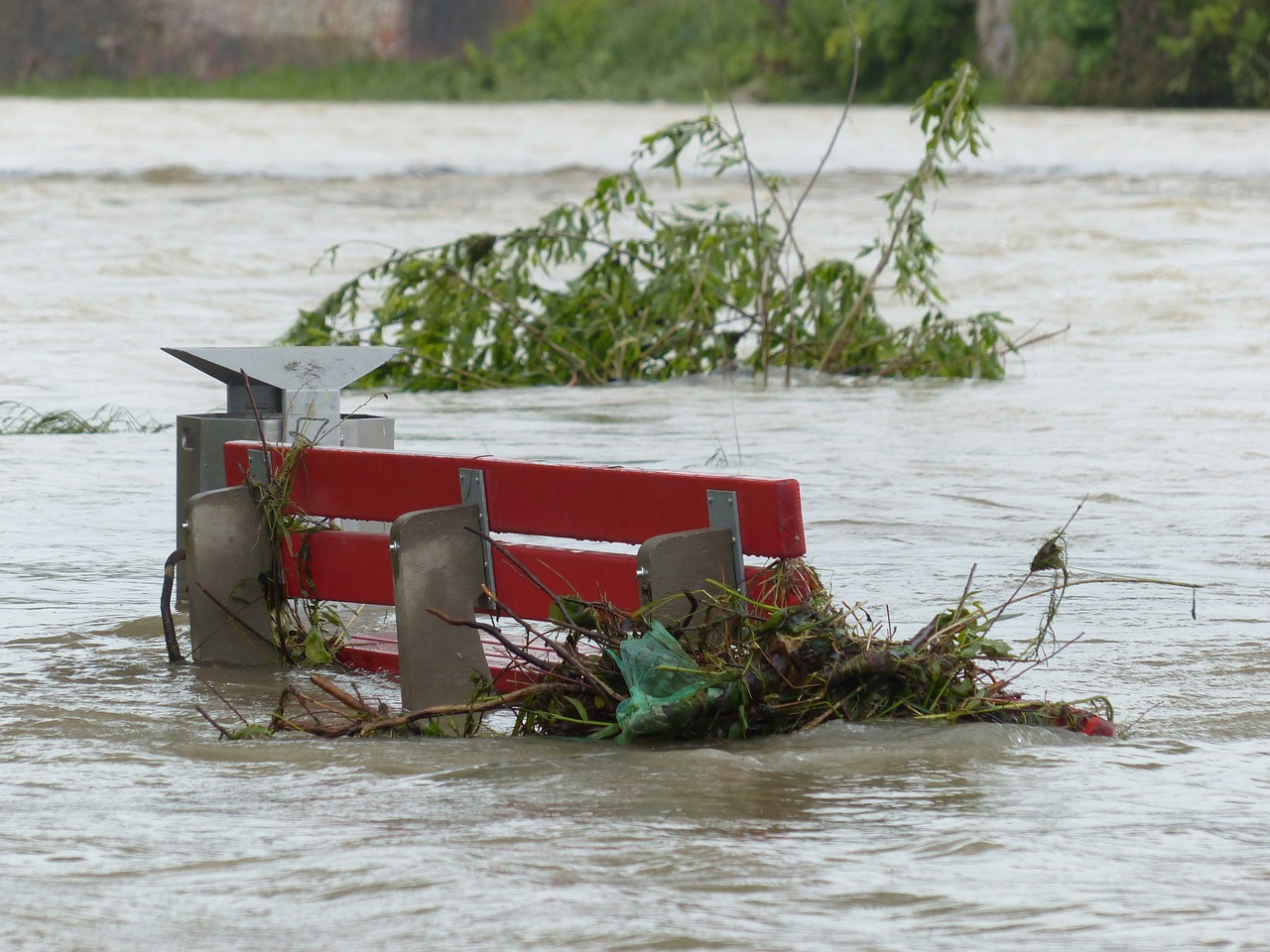
Implementing Counseling Programs
In the aftermath of a disaster, the emotional and psychological toll on survivors can be overwhelming. Health professionals recognize the necessity of addressing these mental health challenges through the implementation of counseling programs. These programs are designed not only to provide immediate support but also to foster long-term recovery and resilience among affected individuals.
One of the primary goals of counseling programs is to create a safe space where survivors can express their feelings and experiences. This is essential because many individuals may feel isolated or misunderstood during such traumatic times. By offering a platform for open communication, health professionals can help individuals process their emotions, which is a crucial step toward healing.
Furthermore, these counseling programs often incorporate various therapeutic techniques tailored to meet the unique needs of different populations. For instance, group therapy sessions can be particularly beneficial as they allow survivors to connect with others who have experienced similar hardships. This shared experience can foster a sense of community and belonging, which is vital for emotional recovery. Additionally, individual counseling sessions provide a more personalized approach, allowing health professionals to address specific issues that may be affecting a survivor's mental health.
To enhance the effectiveness of these programs, health professionals often collaborate with local organizations and community leaders. This collaboration ensures that the counseling services are culturally sensitive and accessible to all community members. By understanding the specific needs and backgrounds of the affected populations, health professionals can tailor their approaches to maximize impact.
Moreover, the integration of technology in counseling programs has revolutionized how mental health support is delivered. Online counseling platforms and mobile applications can provide immediate access to mental health resources, making it easier for survivors to seek help from the comfort of their homes. This is particularly important in disaster scenarios where physical access to counseling centers may be limited.
In summary, implementing effective counseling programs is a fundamental aspect of disaster response that health professionals must prioritize. These programs not only address immediate psychological needs but also contribute to the long-term resilience of individuals and communities. By fostering an environment of support, understanding, and healing, health professionals play a crucial role in helping disaster survivors navigate their recovery journey.
- What types of counseling are available after a disaster? There are various types of counseling available, including individual therapy, group therapy, and family counseling, each tailored to meet the specific needs of survivors.
- How can technology assist in counseling programs? Technology can facilitate online counseling sessions, provide access to mental health resources, and enable communication between health professionals and survivors.
- Why is community collaboration important in counseling? Collaborating with local organizations ensures that counseling services are culturally sensitive and accessible, allowing for a more effective response to the community's needs.
- How do counseling programs contribute to community resilience? By providing emotional support and fostering social connections, counseling programs help individuals recover from trauma, ultimately strengthening the community as a whole.

Community Resilience Building
This article explores the critical functions that health professionals perform during disasters, including their responsibilities, challenges, and the importance of preparedness in ensuring the health and safety of affected populations.
Health professionals play a vital role in coordinating emergency responses, ensuring that medical resources are allocated effectively and that communication channels remain open among various agencies during a disaster.
Monitoring and assessing the health status of populations during disasters is crucial. Health professionals are responsible for public health surveillance to identify emerging health threats and implement timely interventions.
Collecting and analyzing health data during disasters helps to inform response strategies. Health professionals utilize this information to track disease outbreaks and resource needs in affected communities.
Advanced technologies, such as mobile health applications, enhance data collection efficiency. Health professionals leverage these tools to ensure real-time access to critical health information during emergencies.
Effective data management often requires collaboration with local health agencies. Health professionals work together to share insights and improve the overall response to health crises.
Educating communities about health risks and available resources is essential during disasters. Health professionals lead outreach efforts to empower individuals with knowledge and skills to protect their health.
Efficient management of medical resources is crucial in disaster situations. Health professionals are tasked with prioritizing and distributing supplies to ensure that those in need receive timely care.
Assessing the most urgent health needs during a disaster allows health professionals to allocate resources effectively. This prioritization is key to maximizing the impact of available medical supplies.
Health professionals often train and mobilize volunteers to assist in disaster response efforts. This collaboration enhances the capacity to provide care and support to affected populations.
Addressing the mental health needs of disaster survivors is vital. Health professionals provide psychosocial support services to help individuals cope with trauma and stress resulting from the disaster.
Counseling programs are essential for promoting mental well-being. Health professionals develop and implement these programs to assist individuals in managing their emotional responses to disasters.
Community resilience is like the backbone of recovery after a disaster. It’s not just about bouncing back; it’s about bouncing forward, stronger than before. Health professionals play a pivotal role in this process by fostering environments where individuals and communities can thrive despite adversity. They do this by creating networks of support that encourage collaboration and shared resources.
One effective approach health professionals use is to facilitate workshops and training sessions that teach community members essential skills. These can include:
- First aid and emergency response techniques
- Stress management and coping strategies
- Community organizing and leadership skills
By equipping individuals with these skills, health professionals not only empower them but also create a sense of ownership within the community. This ownership is crucial for long-term resilience because it encourages active participation in recovery efforts.
Furthermore, health professionals often collaborate with local organizations and stakeholders to build support networks. These networks can provide emotional support, share resources, and create a sense of belonging among community members. The stronger these connections, the more resilient the community becomes. Think of it as a safety net that catches everyone when disaster strikes, allowing them to recover more quickly.
In addition, health professionals advocate for policies that strengthen community infrastructure, such as improved access to mental health services and social support systems. This advocacy is essential because it ensures that resilience-building efforts are sustainable and integrated into the community’s fabric.
- What is community resilience? Community resilience refers to the ability of a community to withstand and recover from adverse situations, such as disasters, by leveraging its resources and networks.
- How do health professionals contribute to community resilience? Health professionals contribute by providing education, training, and support, as well as advocating for policies that enhance community resources and mental health services.
- Why is mental health important during disasters? Mental health is crucial because it affects individuals' ability to cope with stress and trauma, which can impact their recovery and overall well-being.
Frequently Asked Questions
- What role do health professionals play during a disaster?
Health professionals are crucial during disasters as they coordinate emergency responses, manage resources, and provide essential medical care. They ensure that the health needs of affected populations are met promptly and effectively.
- How do health professionals conduct public health surveillance during disasters?
During disasters, health professionals monitor the health status of communities to identify emerging threats. They collect and analyze data on disease outbreaks and resource needs, which helps in implementing timely interventions to protect public health.
- What technologies do health professionals use for data management in emergencies?
Health professionals utilize advanced technologies, such as mobile health applications, to enhance data collection and management during emergencies. These tools facilitate real-time access to critical health information, allowing for better decision-making.
- How do health professionals collaborate with local agencies during a disaster?
Collaboration with local health agencies is vital for effective data management. Health professionals share insights and resources with these agencies to improve the overall response to health crises, ensuring a coordinated effort in disaster relief.
- What is the importance of community education and outreach in disaster response?
Community education is essential as it empowers individuals with knowledge about health risks and available resources. Health professionals lead outreach efforts to equip communities with the skills needed to protect their health during disasters.
- How do health professionals manage medical resources during a disaster?
Efficient management of medical resources involves assessing priority health needs and distributing supplies accordingly. Health professionals prioritize urgent cases to maximize the impact of the available medical resources.
- What role do volunteers play in disaster response?
Health professionals often train and mobilize volunteers to assist in disaster response efforts. This collaboration enhances the capacity to provide care and support, ensuring that more individuals receive the help they need during crises.
- How do health professionals provide psychosocial support during disasters?
Addressing mental health needs is crucial, so health professionals implement counseling programs to help individuals cope with trauma. These programs promote emotional well-being and assist survivors in managing their responses to the disaster.
- What is community resilience, and how do health professionals contribute to it?
Community resilience refers to the ability of a community to recover from disasters. Health professionals foster social support networks that are essential for recovery, helping individuals and communities build strength and resilience in the aftermath of a disaster.

